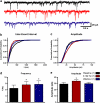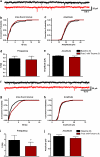The abused inhalant toluene differentially modulates excitatory and inhibitory synaptic transmission in deep-layer neurons of the medial prefrontal cortex
- PMID: 21430649
- PMCID: PMC3096820
- DOI: 10.1038/npp.2011.38
The abused inhalant toluene differentially modulates excitatory and inhibitory synaptic transmission in deep-layer neurons of the medial prefrontal cortex
Abstract
Volatile organic solvents such as toluene are voluntarily inhaled for their intoxicating effects. Solvent use is especially prevalent among adolescents, and is associated with deficits in a wide range of cognitive tasks including attention, behavioral control, and risk assessment. Despite these findings, little is known about the effects of toluene on brain areas mediating these behaviors. In this study, whole-cell patch-clamp recordings were used to determine the effect toluene on neurons within the medial PFC, a region critically involved in cognitive function. Toluene had no effect on measures of intrinsic excitability, but enhanced stimulus-evoked γ-amino butyric acid A-mediated inhibitory postsynaptic currents (IPSCs). In the presence of tetrodotoxin (TTX) to block action potentials, toluene increased the frequency and amplitude of miniature IPSCs. In contrast, toluene induced a delayed but persistent decrease in evoked or spontaneous AMPA-mediated excitatory postsynaptic currents (EPSCs). This effect was prevented by an intracellular calcium chelator or by the ryanodine receptor and SERCA inhibitors, dantrolene or thapsigargin, respectively, suggesting that toluene may mobilize intracellular calcium pools. The toluene-induced reduction in AMPA EPSCs was also prevented by a cannabinoid receptor (CB1R) antagonist, and was occluded by the CB1 agonist WIN 55,212-2 that itself induced a profound decrease in AMPA-mediated EPSCs. Toluene had no effect on the frequency or amplitude of miniature EPSCs recorded in the presence of TTX. Finally, toluene dose-dependently inhibited N-methyl-D-aspartate (NMDA)-mediated EPSCs and the magnitude and reversibility of this effect was CB1R sensitive indicating both direct and indirect actions of toluene on NMDA-mediated responses. Together, these results suggest that the effect of toluene on cognitive behaviors may result from its action on inhibitory and excitatory synaptic transmission of PFC neurons.
Figures









References
-
- Bale AS, Tu Y, Carpenter-Hyland EP, Chandler LJ, Woodward JJ. Alterations in glutamatergic and gabaergic ion channel activity in hippocampal neurons following exposure to the abused inhalant toluene. Neuroscience. 2005;130:197–206. - PubMed
-
- Beckstead MJ, Weiner JL, Eger EI, II, Gong DH, Mihic SJ. Glycine and gamma-aminobutyric acid(A) receptor function is enhanced by inhaled drugs of abuse. Mol Pharmacol. 2000;57:1199–1205. - PubMed
-
- Benignus VA, Muller KE, Barton CN, Bittikofer JA. Toluene levels in blood and brain of rats during and after respiratory exposure. Toxicol Appl Pharmacol. 1981;61:326–334. - PubMed
-
- Blokhina EA, Dravolina OA, Bespalov AY, Balster RL, Zvartau EE. Intravenous self-administration of abused solvents and anesthetics in mice. Eur J Pharmacol. 2004;485:211–218. - PubMed
Publication types
MeSH terms
Substances
Grants and funding
LinkOut - more resources
Full Text Sources
Miscellaneous

